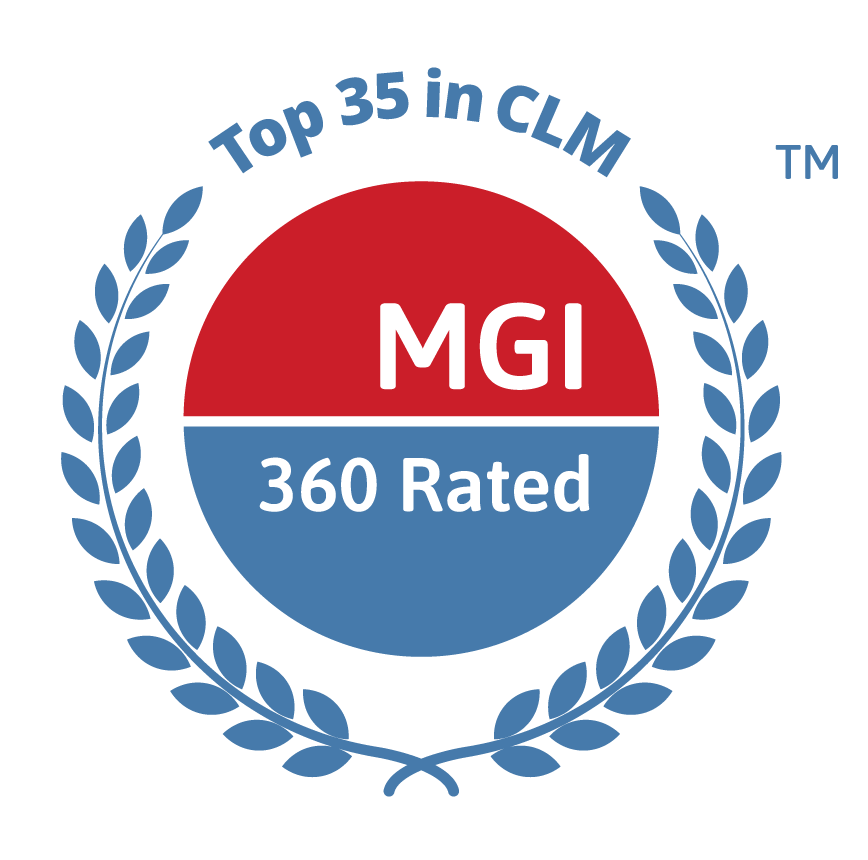
Contract Lifecycle Management (CLM) is the comprehensive process of strategically managing the entire lifespan of a legally binding agreement between two or more parties within a business context. It encompasses the stages or phases that a contract goes through from its creation to its conclusion, while applying effective planning, organizing, coordination, and control techniques to achieve specific goals and objectives.
CLM involves the systematic handling of contracts, ensuring that they are effectively managed and administered throughout their lifecycle. It encompasses activities such as contract creation, negotiation, execution, monitoring, renewal, and closure. During the contract lifecycle, the rights, obligations, and terms of the commercial relationship between the involved parties are carefully governed and enforced.
By employing CLM, organizations can effectively manage and optimize their contractual relationships, ensuring compliance with legal and business requirements, minimizing risks, and maximizing the value derived from contracts. It enables businesses to navigate through the different stages of a contract’s existence, from its initiation during the inception of the business to its eventual termination or transformation, while achieving desired outcomes and maintaining transparency and control over the entire process.
CLM Landscape
The CLM landscape is maturing rapidly and shifting from static document management to a dynamic transactional system that can tightly integrate with other key enterprise transactional components, such as CRM, CPQ, Billing, and Revenue Recognition. Progressive organizations today see CLM’s role as more holistic with critical impact across supply chain, procurement, purchasing, sales, support, field service, billing, revenue recognition, order management, HR, finance, compliance, legal, and R&D, among other areas.
Key advances in CLM functionality are propelling CLM into becoming a recognized enterprise system of record. The growth in CLM adoption is fueled by digital transformation and a refocusing of technology investment away from traditional ERP/Financials suites towards automating and digitally instrumenting key processes. Organizations that take advantage of these new capabilities will achieve breakthroughs in their ability to integrate key processes across finance, sales, manufacturing, compliance, and risk management.
The Six Stages of CLM
Stage 1: Contract e-Document provides capabilities to convert from paper to electronic copies of documents allowing remote access and sharing.
Stage 2: Contract E-Signature provides electronic signature capabilities, removing the need for generating paper copies during the contracting process. Contracts can be signed remotely by all parties, and signature certificates provided in secure electronic form acceptable to regulatory and judicial bodies.
Stage 3: Contract Workflow Automation ensures that the contract review processes can match organizational requirements and that contract processing can be monitored for completeness, timing, and compliance.
Stage 4: Contract Authoring Automation provides tools to automate and accelerate the contract creation and maintenance process by allowing the use of pre-defined contract and clause templates, document variables, and external data elements.
Stage 5: Contract Intelligence provides analysis tools for comparing document and clause versions, identifying document patterns and clauses, highlighting non-standard and non-compliant language not only at a single document level but in the context of entire contract libraries. Stage 5 includes tools for legacy contract ingestion and conversion. AI tools are used to support the capabilities of Stage 5. Stage 5 also provides inputs into contract blockchains by extracting and tokenizing contracts or clauses.
Stage 6: Contract Execution is the data abstraction of the economic and legal relationships documented in a contract. It creates data elements that are addressable programmatically from other parts of the enterprise – the so-called Internet of Knowledge. Stage 6 supports blockchain-like smart contract execution that initiates review, provides alerts, and recommends/ensures enforcement action (e.g. penalty clauses, minimum payments).
Why Does CLM Matter?
As companies ask their in-house legal and business teams to accomplish more with limited resources, the key to efficient operations lies in identifying and implementing the appropriate tools, techniques, and technology.
The popularity of contract management and contract management systems started to rise in the early 2000s. Previously, in-house legal teams would improvise their own makeshift management solutions, such as email chains and spreadsheets, or rely on intricate database management systems to handle their contracts.
This decentralized approach, where contracts were scattered across filing cabinets, local drives, and other locations, exposed companies to significant risks. That is why, initially, contract management primarily focused on the post-execution aspect, specifically storing agreements in a centralized location.
Nevertheless, contracts were still considered static documents that called for static solutions, often resulting in a “file-and-forget” approach where contracts were archived and forgotten. The logical response was the implementation of a contract database. However, those who work with contracts know that they are dynamic documents, with upcoming renewal dates, force majeure clauses, and the impact of changing state and federal regulations. These aspects necessitate adaptable solutions.
Evolution of CLM:
Contract lifecycle management (CLM) is undergoing significant evolution in the business world today. Advancements in technology, changing market dynamics, and the need for increased efficiency and compliance have driven this evolution. CLM solutions are adapting to meet the evolving needs of businesses, offering enhanced features and capabilities that optimize the management of contracts throughout their lifecycle.
One major aspect of CLM evolution is the automation and digitization of contract processes. Businesses are increasingly adopting CLM software that automates manual tasks, streamlines contract creation and approval workflows, and facilitates seamless collaboration among stakeholders. This automation improves efficiency, reduces errors, and accelerates the contract lifecycle.
Moreover, the integration of artificial intelligence (AI) and machine learning (ML) technologies is transforming CLM. AI-powered CLM systems can analyze large volumes of contracts, extract key data, and provide valuable insights for better decision-making. Machine learning algorithms can identify patterns, flag risks, and optimize contract negotiation and management processes.
Additionally, CLM is evolving to address the growing complexity of regulatory compliance and risk management. Modern CLM solutions integrate compliance features that help organizations track regulatory changes, ensure contract compliance, and mitigate risks associated with non-compliance. These solutions provide real-time alerts, compliance dashboards, and contract analytics to support proactive risk management.
Furthermore, CLM is becoming more integrated with other enterprise systems such as ERP and CRM platforms. This integration allows for seamless data flow and provides organizations with a unified view of contract-related information, financials, and customer data. It enables better decision-making, improved operational efficiency, and enhanced customer relationship management.
Overall, CLM is evolving to meet the evolving needs of businesses in an increasingly digital and complex business environment. The adoption of automation, AI, and integration with other systems is revolutionizing how contracts are managed, enabling organizations to streamline processes, reduce risks, enhance compliance, and optimize contract outcomes. The future of CLM lies in continued innovation and the integration of emerging technologies that further enhance its capabilities and drive business success.
Benefits of CLM:
Forward-thinking companies with ambitious long-range objectives are increasingly embracing CLM platforms as the sole genuine method to ensure that their contract workflow remains aligned with the rapid pace of contemporary business.
A few of these benefits are listed below:
- Time-saving benefits can be achieved through the implementation of digital contracting. By adopting a comprehensive platform accessible to all, the frustrating cycle of rushing and waiting associated with contracts can be eliminated. An example of reduced turnaround time is demonstrated by Dropbox’s utilization of Ironclad. Through this partnership, they were able to expedite the processing of 2000 Inbound Services Agreements and Statements of Work annually, reducing the time required from weeks to minutes. As a result, numerous contract-related tickets were eliminated.
- By implementing digital contracting, you can streamline and automate a significant portion of the contract process, leading to a reduction in the quantity of individual contracts that need to be generated and reviewed.
- CLM software facilitates seamless collaboration within a single integrated platform, enabling transparent visibility of edits and streamlined acceptance of redlines. Moreover, it empowers you to work efficiently and obtain timely responses to critical inquiries from your leadership.
- Numerous businesses hold the belief that expediting the contract process could potentially compromise their operations, leading to higher risks compared to the traditional approach of manually creating and reviewing each contract. However, with a suitable CLM solution, such concerns become irrelevant. In fact, digital contracting ensures accountability within your team, fosters transparency, and generates alerts to uphold and enhance your security and compliance measures.
- The ability to drive revenue growth and cost savings. Fitbit serves as an excellent illustration of leveraging CLM platforms to generate significant financial benefits. Through the implementation of contract generation and routing automation, Fitbit managed to achieve annual savings of over $60,000.
Key Issues/FAQ
Vendors:
- What is the realistic size and total addressable market (TAM) for CLM?
- What are the critical and emerging requirements for a modern CLM platform?
- What factors will drive adoption of CLM?
- What new channel and marketing alliances are likely to emerge for CLM?
- Which companies are likely new market entrants or disruptors?
- What are the key metric and valuation trends for successful CLM software suppliers?
Buyers:
- What is Contract Lifecycle Management (CLM), and what are CLM best practices?
- What are the critical CLM capabilities today and how will CLM evolve?
- What new cost savings and top line revenue growth is possible with modern CLM?
- How should organizations plan, organize, and budget for CLM adoption?
- How should organizations plan to integrate CLM into the digital enterprise?
- How do CLM solutions compare in terms of cost, implementation times, and benefits delivered?
Leading Suppliers
CLM is no longer a back-office discipline. With integration into the rest of the enterprise ecosystem, it is becoming critical in affecting many key front-office functions such as sales, support, and customer retention. The CLM landscape is continuously evolving and thus challenging to navigate when critical decisions that impact the future performance of the business need to be made.
- AbacusNext
- Agiloft
- ASC
- clmMatrix
- Cobblestone
- Concord
- Conga
- ContractLogix
- ContractSafe
- ContractWorks
- Corcentric
- CorridorCompany
- Coupa
- CurtisFitch
- DocuSignCLM
- Ecteon
- GEP
- Gimmal
- GreatMindsSoftware
- Icertis
- Infor
- Ironclad
- Ivalua
- Jaggaer
- Malbek
- ParleyPro
- Pramata
- SAP
- SirionLabs
- SymFact
- Synertrade
- ThomsonReuters
- Updraft
- Wolters Kluwer
- Zycus



